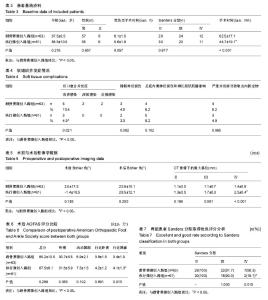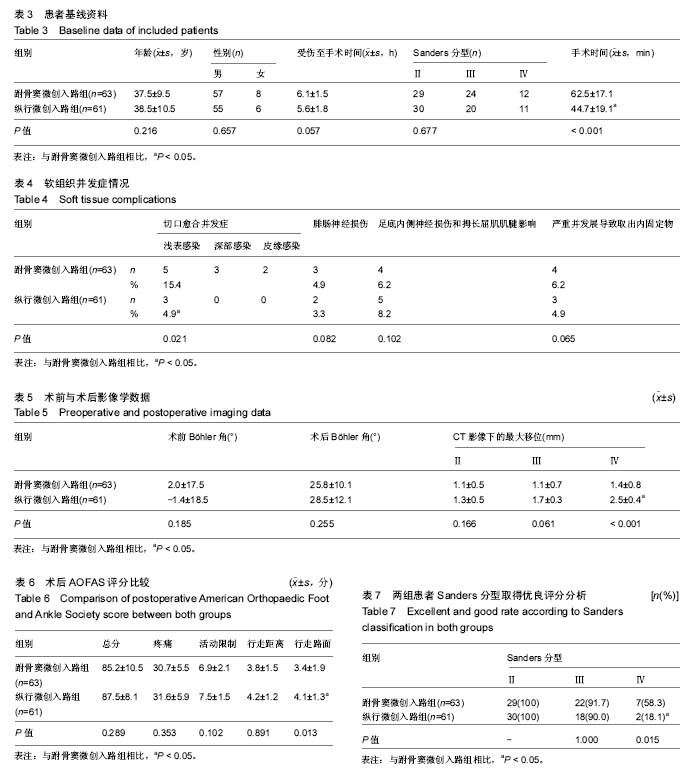| [1] Shawen SB, Keeling JJ, Branstetter J, et al. The mangled foot and leg: salvage versus amputation. Foot Ankle Clin. 2010; 15(1):63-75.[2] 范爱民,何志,张立亮,等. 经皮克氏针固定与小切口复位植骨修复跟骨骨折:优势及缺陷[J]. 中国组织工程研究,2014,18(48): 7822-7826.[3] 杨振军,何新泽,孙勃,等.改良“L”型切口治疗跟骨骨折疗效及并发症相关因素研究[J].中国矫形外科杂志, 2015,23(12): 1123-1126. [4] 吴和平,李芬芳,孙惠萍.跟骨骨折术后早期康复护理[J].护士进修杂志, 2015,30(18):1697-1699. [5] Potter MQ, Nunley JA. Long-term functional outcomes after operative treatment for intra-articular fractures of the calcaneus. J Bone Joint Surg Am. 2009;91(8):1854-1860. [6] 姚琦,仇永辉,祝孟海,等.跟骨骨折术后切口并发症的分析及预防策略[J].中华创伤骨科杂志,2015,17(9):757-760. [7] 周明,金绍林,江建平,等.锁定接骨板内固定治疗移位的关节内跟骨骨折[J].临床骨科杂志,2015,18(3):362-364. [8] 宋兵华,孙俊英,倪增良,等.影响移位关节内跟骨骨折手术疗效的因素[J].中华创伤杂志, 2015,31(10):941-946. [9] 刘新成,陈雁西,俞光荣.手术治疗跟骨骨折并发症的Meta分析[J].中华创伤杂志,2010,26(2):109-113. [10] Maskill JD, Bohay DR, Anderson JG. Calcaneus fractures: a review article. Foot Ankle Clin. 2005;10:463-489.[11] Mc Bride DJ, Rammamurthy C, Laing P. The hindfoot: calcaneal and talar fractures and dislocations-Part I: Fractures of the calcaneus. Curr Orthop. 2005;19:94-100. [12] Mostafa MF, El-Adl G, Hassanin EY, et al. Surgical treatment of displaced intra-articular calcaneal fracture using a single small lateral approach. Strategies Trauma Limb Reconstr. 2010;5:87-95. [13] Schepers T, Kieboom BCT, Bessems GHJM, et al. Subtalar versus triple arthrodesis after intra-articular calcaneal fractures. Strategies Trauma Limb Reconstr. 2010;5(2): 97-103. [14] Ågren PH, Tullberg T, Mukka S, et al. Post-traumatic in situ fusion after calcaneal fractures: a retrospective study with 7–28 years follow-up. Foot Ankle Surg. 2015;21(1):56-59. [15] Zhang T, Su Y, Chen W, et al. Displaced intra-articular calcaneal fractures treated in a minimally invasive fashion: longitudinal approach versus sinus tarsi approach. J Bone Joint Surg Am. 2014;96(4):302-309. [16] Pezzoni M, Salvi AE, Tassi M, et al. A minimally invasive reduction and synthesis method for calcaneal fractures: the “Brixian bridge” technique. J Foot Ankle Surg. 2009;48(1): 85-88. [17] Wang X, Mei J, Li S, et al. Percutaneous reduction combined with bone graft in treatment of displaced intra-articular calcaneal fractures. J Med Colleges PLA. 2009;24(1):38-44. [18] Atmaca H, Memisoglu K, Baran T, et al. Treatment of calcaneal fractures with closed reduction and the endobutton-assisted technique: short-term analysis. J Am Podiatr Med Assoc. 2015;105(1):33-41. [19] Wu Z, Su Y, Chen W, et al. Functional outcome of displaced intra-articular calcaneal fractures: a comparison between open reduction/internal fixation and a minimally invasive approach featured an anatomical plate and compression bolts. J Trauma Acute Care Surg. 2012;73(3):743-751. [20] Schepers T. The sinus tarsi approach in displaced intra-articular calcaneal fractures: a systematic review. Int Orthop. 2011;35(5):697-703. [21] Kitaoka HB, Alexander IJ, Adelaar RS, et al. Clinical rating systems for the ankle-hindfoot, midfoot, hallux, and lesser toes. Foot Ankle Int. 1997;18(3):187-188. [22] Folk JW, Starr AJ, Early JS. Early wound complications of operative treatment of calcaneus fractures: analysis of 190 fractures. J Orthop Trauma. 1999;13(5):369-372. [23] [Koski A, Kuokkanen H, Tukiainen E. Postoperative wound complications after internal fixation of closed calcaneal fractures: a retrospective analysis of 126 consecutive patients with 148 fractures. Scand J Surg. 2005;94(3):243-245. [24] Nosewicz T, Knupp M, Barg A, et al. Mini-open sinus tarsi approach with percutaneous screw fixation of displaced calcaneal fractures: a prospective computed tomography–based study. Foot Ankle Int. 2012;33(11): 925-933. [25] 董鑫华,孙晓,柴君雷,等.经跗骨窦入路微型锁定钢板内固定治疗跟骨骨折[J].中医正骨,2014,26(11):42-44. [26] 吴旻昊,蔡林,邓洲铭,等.跗骨窦入路治疗跟骨骨折的研究进展[J].中华创伤骨科杂志,2017,19(3):272-276. [27] 马胡晶,周君琳.开始部分负重与完全负重功能锻炼对SandersⅡ~Ⅲ型跟骨骨折切开复位内固定术后患者足部功能的影响[J].临床和实验医学杂志,2017,16(11):1136-1138. [28] 付尧,王金成,贾云龙,等.SandersⅡ~Ⅲ型跟骨骨折术后完全负重练习开始时间与足部功能关系[J].中华骨与关节外科杂志, 2015,8(1):62-65. [29] Nosewicz T, Knupp M, Barg A, et al. Mini-open sinus tarsi approach with percutaneous screw fixation of displaced calcaneal fractures: a prospective computed tomography–based study. Foot Ankle Int. 2012;33(11): 925-933. [30] Kingwell S, Buckley R, Willis N. The association between subtalar joint motion and outcome satisfaction in patients with displaced intraarticular calcaneal fractures. Foot Ankle Int. 2004;25(9):666-673. |

